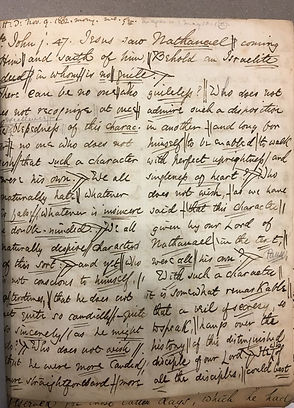
Revitalizing Manuscript Sermons of the
18th & 19th Century as Oral Ephemera
manuscript medium
Anonymous Author:
Thinkpad
Sermons.
The 1707 preacher has acquired a vertical notepad to record their religious thoughts and preserve sermons for their temporary reference. The small size allows for the paper to be easily stored and conveniently retrieved on a day-to-day basis when the preacher feels the need. The paper is of regular stock but the preacher is content to use this medium for their manuscript sermons because their goal is not long-term preservation but rather, everyday convenience.
The preacher flips their vertical notebook to the next empty page and starts their next entry by first creating the margins. They scrawl two perpendicular lines before writing the page number down and redrawing any part of the line that is thin. They continue the sermon in their handwritten style, a small cursive script that fills up the small page. The preacher rushes to get their ideas onto the page and is unconcerned with spacing or legibility. In the margin they write a note for their future selves that denotes the subject of the sermon.

Anonymous Author:
Half Bound Sermons
Essays & Sermons.
The 1801 preacher has chosen to hand-write their sermons on paper half-bound in hide. The binding is enough to hold the paper together but is a cheap alternative to costly leather or vellum. Besides, the preacher is mainly concerned with writing sermons that'll soon occur to him so that he can recite the sermons in a year or two. Perhaps one day the half-bound spine will not be enough to support the paper, but these sermons will probably be disposed of in a few years once he's either memorized them or found better material.


Henry Scadding sits down to write out a sermon he’ll be delivering to his congregation later. He uses the most convenient paper to write it down and starts with the passage from John he’ll be ruminating on this November day. He’s mainly concerned with writing the sermon down for his own recitation, utilizing abbreviations and his distinct cursive script. It’s easy to write down, in fact, it comes out just as he would say it. He adds oratory queues to help him remember, brackets to separate the ideas and underlined words to be accentuated for the congregation. He revisits the sermon a year later to make amendments in pencil.
Henry Scadding:
Sermons record the
commonality of Life
John-Romans
Often, this “characteristic of disposability has its own problems” as archivist struggle to find ephemera that haven’t been simply thrown out after their purpose was served (Suarez ch. 16).


